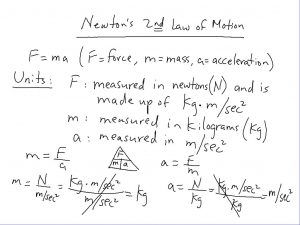Question 1: How can a small object (small mass) have the same kinetic energy as a large object (large mass)?
If two objects have a KE of 50 J, and one object has mass of 1 kg moving at 10 m/s while the other has mass of 100 kg moving at 1 m/s, then they both have the same K.E.
KE= ½ m v² KE= ½ m v²
50 J = ½ (1 kg) (10 m/s)² 50 J = ½ (100 kg) (1 m/s)²
50 J = ½ (1 kg) 100 m²/s² 50 J = ½ (100 kg) 1 m²/s²
50 J = 50 J 50 J = 50 J
***Note that the smaller object tends to have a higher velocity.***
***Note that the larger object tends to have a lower velocity.***
Question 2: How can an object with a small velocity have the same kinetic energy as an object with a large velocity?
If two objects have a KE of 50 J, and one object has mass of 1 kg moving at 10 m/s while the other has mass of 100 kg moving at 1 m/s, then they both have the same K.E.
KE= ½ m v² KE= ½ m v²
50 J = ½ (100 kg) (1 m/s)² 50 J = ½ (1 kg) (10 m/s)²
50 J = ½ (100 kg) 1 m²/s² 50 J = ½ (1 kg) 100 m²/s²
50 J = 50 J 50 J = 50 J
***Note that the larger object tends to have a lower velocity.***
***Note that the smaller object tends to have a higher velocity.***
�
Question 3: What happens to the kinetic energy if you double the mass?
One ball has a mass of 5 kg and the other has as mass of 10 kg. They are both thrown at a speed of 20 m/s. What is the difference in their KE?
KE= ½ m v² KE= ½ m v²
KE = ½ (5 kg) (20 m/s)² KE = ½ (10 kg) (20 m/s)²
KE = ½ (5 kg) 400 m²/s² KE = ½ (10 kg) 400 m²/s²
KE = 1,000 J KE = 2,000 J
The KE of the more massive ball is double the the KE of the less massive ball.
Question 4: What happens to the kinetic energy if you double the velocity?
Two balls have a mass of 5 kg. One is thrown at 10 m/s and the other is thrown at a speed of 20 m/s. What is the difference in their KE?
KE= ½ m v² KE= ½ m v²
KE = ½ (5 kg) (10 m/s)² KE = ½ (5 kg) (20 m/s)²
KE = ½ (5 kg) 100 m²/s² KE = ½ (5 kg) 400 m²/s²
KE = 250 J KE = 1,000 J
The KE of the faster moving ball is 4 times the KE of the slower moving ball.

